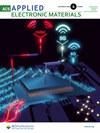Polarity Flipping in SnSe Empowering Wavelength Selective Self-Powered Broadband Photodetection
IF 4.3
3区 材料科学
Q1 ENGINEERING, ELECTRICAL & ELECTRONIC
引用次数: 0
Abstract
The demand for high-performance self-powered photodetectors with broadband wavelength selectivity has intensified due to their applications in various fields such as imaging, sensing, communication, and environmental monitoring. Among emerging materials, tin selenide (SnSe) has garnered significant attention for its promising optoelectronic properties. In this study, we have investigated the phenomenon of polarity flipping in sputtering-grown pure SnSe film and its impact on broadband wavelength selective photodetection. The designed metal semiconductor metal device with an active area of 9 μm2 exhibits a maximum responsivity of 10.82 mAW–1, a high external quantum efficiency of 378.76%, and the lowest noise equivalent power of 5.3 × 10–13 WHz–1/2 for 1064 nm light illumination of optical power 16.2 nW in self-bias mode. The proposed pure SnSe-based device exhibits wavelength-dependent polarity switching in self-bias mode for the spectral range UV–NIR, enabling the device to function in bidirectional mode. The polarity flipping response in the photodetector makes it possible to differentiate between different photons, such as ultraviolet/visible and near-infrared. This capability can improve the accuracy and efficiency of environmental monitoring systems, enabling better detection and analysis of various environmental factors, such as light pollution, radiation levels, and atmospheric composition. We elucidated the possible phenomenon underlying polarity flipping through a comprehensive characterization of the material’s structural, optical, and electrical properties. Our findings reveal that the controlled phase during sputter deposition can significantly alter the crystalline structure, resulting in tunable optical properties and enhanced photoresponse across a broad wavelength range. Additionally, the polarity flipping phenomenon enables the photodetector to exhibit unprecedented broadband wavelength selectivity, thus opening avenues for developing advanced optoelectronic devices. This research advances our fundamental understanding of phase-controlled SnSe thin film and paves the way for designing and fabricating highly efficient self-powered photodetectors with tailored spectral response characteristics.

硒化硒中的极性翻转赋予波长选择性自供电宽带光电探测功能
由于在成像、传感、通信和环境监测等各个领域的应用,对具有宽带波长选择性的高性能自供电光电探测器的需求日益增长。在新兴材料中,硒化锡(SnSe)因其良好的光电特性而备受关注。在这项研究中,我们研究了溅射生长的纯硒化锡薄膜的极性翻转现象及其对宽带波长选择性光电探测的影响。所设计的金属半导体金属器件有源面积为 9 μm2,在自偏压模式下,光功率为 16.2 nW 的 1064 nm 光照射下,最大响应率为 10.82 mAW-1,外部量子效率高达 378.76%,噪声等效功率最低为 5.3 × 10-13 WHz-1/2。在紫外-近红外光谱范围内,所提出的纯锡基器件在自偏压模式下表现出与波长相关的极性切换,使器件能够在双向模式下工作。光电探测器的极性翻转响应使其能够区分紫外/可见光和近红外等不同光子。这种能力可以提高环境监测系统的准确性和效率,从而更好地检测和分析各种环境因素,如光污染、辐射水平和大气成分。我们通过对材料的结构、光学和电学特性进行综合分析,阐明了极性翻转背后可能存在的现象。我们的研究结果表明,溅射沉积过程中的受控相位可显著改变晶体结构,从而在宽广的波长范围内产生可调的光学特性和增强的光响应。此外,极性翻转现象使光电探测器表现出前所未有的宽带波长选择性,从而为开发先进的光电器件开辟了道路。这项研究推进了我们对相位控制 SnSe 薄膜的基本了解,并为设计和制造具有定制光谱响应特性的高效自供电光电探测器铺平了道路。
本文章由计算机程序翻译,如有差异,请以英文原文为准。
求助全文
约1分钟内获得全文
求助全文

 求助内容:
求助内容: 应助结果提醒方式:
应助结果提醒方式:


